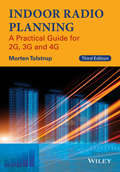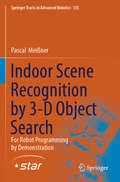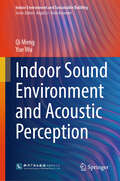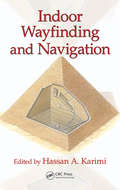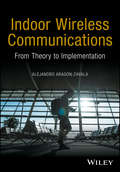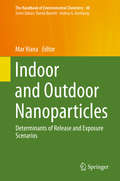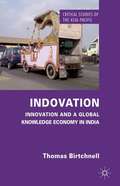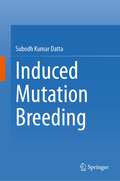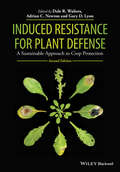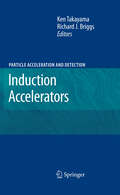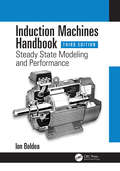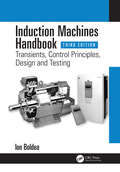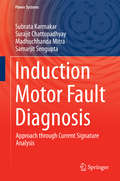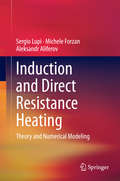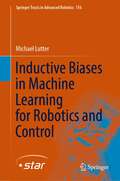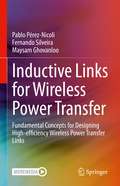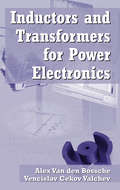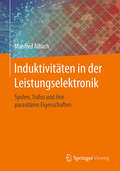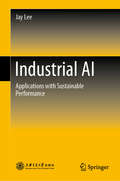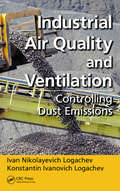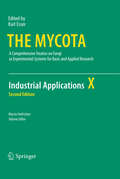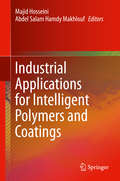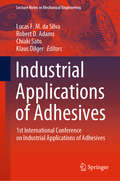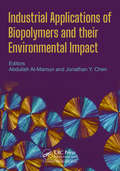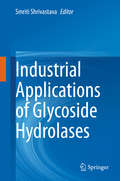- Table View
- List View
Indoor Radio Planning: A Practical Guide for 2G, 3G and 4G
by Morten TolstrupWhy is high performance indoor wireless service needed, and how is it best implemented? As the challenge of providing better service and higher data speeds and quality for mobile applications intensifies, ensuring adequate in-building and tunnel coverage and capacity is increasingly important. A unique, single-source reference on the theoretical and practical knowledge behind indoor and tunnel radio planning, this book provides a detailed overview of mobile networks systems, coverage and capacity solutions with 2G, 3G and 4G cellular system technologies as a backdrop.
Indoor Scene Recognition by 3-D Object Search: For Robot Programming by Demonstration (Springer Tracts in Advanced Robotics #135)
by Pascal MeißnerThis book focuses on enabling mobile robots to recognize scenes in indoor environments, in order to allow them to determine which actions are appropriate at which points in time. In concrete terms, future robots will have to solve the classification problem represented by scene recognition sufficiently well for them to act independently in human-centered environments. To achieve accurate yet versatile indoor scene recognition, the book presents a hierarchical data structure for scenes – the Implicit Shape Model trees. Further, it also provides training and recognition algorithms for these trees. In general, entire indoor scenes cannot be perceived from a single point of view. To address this problem the authors introduce Active Scene Recognition (ASR), a concept that embeds canonical scene recognition in a decision-making system that selects camera views for a mobile robot to drive to so that it can find objects not yet localized. The authors formalize the automatic selection of camera views as a Next-Best-View (NBV) problem to which they contribute an algorithmic solution, which focuses on realistic problem modeling while maintaining its computational efficiency. Lastly, the book introduces a method for predicting the poses of objects to be searched, establishing the otherwise missing link between scene recognition and NBV estimation.
Indoor Sound Environment and Acoustic Perception (Indoor Environment and Sustainable Building)
by Qi Meng Yue WuThis book mainly presents the state-of-the-art development in indoor sound environment. Not simply introducing the research on the acoustic environment or noise level of indoor building, the book considers the differences in the function of buildings and the perception of acoustic environment, as well as the relationship between sound quality and health and behavior. The book includes the multidisciplinary studies in architecture, acoustics, environmental science, psychology, sociology, and management. Therefore, it is used as a guide for government decision-makers, developers, planners, and architects to understand the effects of architectural design on building acoustic environment.
Indoor Wayfinding and Navigation
by Hassan A. KarimiDue to the widespread use of navigation systems for wayfinding and navigation in the outdoors, researchers have devoted their efforts in recent years to designing navigation systems that can be used indoors. This book is a comprehensive guide to designing and building indoor wayfinding and navigation systems. It covers all types of feasible sensors (for example, Wi-Fi, A-GPS), discussing the level of accuracy, the types of map data needed, the data sources, and the techniques for providing routes and directions within structures.
Indoor Wireless Communications: From Theory to Implementation
by Alejandro Aragón-ZavalaIndoor Wireless Communications: From Theory to Implementation provides an in-depth reference for design engineers, system planners and post graduate students interested in the vastly popular field of indoor wireless communications. It contains wireless applications and services for in-building scenarios and knowledge of key elements in the design and implementation of these systems. Technologies such as Wireless Local Area Networks, Bluetooth, ZigBee, Indoor Optical Communications, WiMAX, UMTS and GSM for indoor environments are fully explained and illustrated with examples. Antennas and propagation issues for in-building scenarios are also discussed, emphasizing models and antenna types specifically developed for indoor communications. An exhaustive survey on indoor wireless communication equipment is also presented, covering all available technologies including antennas, distribution systems, transceivers and base stations.
Indoor and Outdoor Nanoparticles
by Mar VianaThis volume provides an overviewof the determinants of the release of and exposure to airborne nanoparticles. Whetherintentionally manufactured or unintentionally generated during industrial processes,the release of nanoparticles can result in significant worker exposure, whichmust be dealt with adequately by means of dedicated risk assessments to ensureworkplace health and safety. The book extensively discusses a number ofmeasurement and modelling strategies available for this purpose. It also reviewsthe health hazardous potential of nano-sized particles and fibres, and follows theflow of engineered nanomaterials from production and use to disposal and theenvironment. It appeals to a wide readership, from specialists already workingin the field to newcomers aiming to gain insights into this topic.
Indovation
by Thomas BirtchnellHow should we understand the many reports that poverty is the mother of innovation in India? What has the role of austerity been in the development of India's knowledge economy? In this critical study of Indian innovation, or 'Indovation', Thomas Birtchnell explores how the complex mobilities of 'globals' with stakes in India have transformed discourses and imaginaries about innovation in the region. He adopts a critical eye to the notion of Indovation by focusing on the various circuits of globals where India's knowledge economy is concentrated: expertise, entrepreneurship and community. Birtchnell traces the various discourses and counter-discourses around an Indian way of working and illustrates how differences in the international dimensions of austerity allow India's knowledge economy to prosper.
Induced Mutation Breeding
by Subodh Kumar DattaThe book is an excellent reference collection of the research conducted by different workers on induced mutagenesis, worldwide, for more than 80 years. One can get almost all mutation breeding references at one place. The book gives a coherent and concise account of all the important and relevant aspects related to induced mutagenesis with an emphasis on recent developments in the field of crop improvement. The references have been arranged crop wise and important topic wise which deal with not only classical mutation breeding but also spontaneous mutations, somaclonal variations, nanoparticles, and relevant modern aspects. The book highlights 22 chapters covering holistic information on almost all important components such as radiosensitivity, chromosomal and morphological abnormalities, detection of mutation, management of chimera, present status of mutation etc.) of Mutation Breeding. Chapters are very informative, and one can follow the references on crop and aspect basis since the start of mutation breeding work. This book is an excellent resource for researchers and students for understanding proper applications of induced mutations in crop improvement and biological research. It is of interest and useful to graduate and postgraduate students, horticulturists, floriculturists, agricultural scientists, and breeders related to crop improvement program.
Induced Resistance for Plant Defense: A Sustainable Approach to Crop Protection
by Adrian C. Newton Professor Dale R. Walters Gary D. LyonInduced resistance offers the prospect of broad spectrum, long-lasting and potentially environmentally-benign disease and pest control in plants. Induced Resistance for Plant Defense 2e provides a comprehensive account of the subject, encompassing the underlying science and methodology, as well as research on application of the phenomenon in practice. The second edition of this important book includes updated coverage of cellular aspects of induced resistance, including signalling and defenses, costs and trade-offs associated with the expression of induced resistance, research aimed at integrating induced resistance into crop protection practice, and induced resistance from a commercial perspective. Current thinking on how beneficial microbes induce resistance in plants has been included in the second edition. The 14 chapters in this book have been written by internationally-respected researchers and edited by three editors with considerable experience of working on induced resistance. Like its predecessor, the second edition of Induced Resistance for Plant Defense will be of great interest to plant pathologists, plant cell and molecular biologists, agricultural scientists, crop protection specialists, and personnel in the agrochemical industry. All libraries in universities and research establishments where biological, agricultural, horticultural and forest sciences are studied and taught should have copies of this book on their shelves.
Induction Accelerators
by Ken Takayama Richard J. BriggsA broad class of accelerators rests on the induction principle whereby the accelerating electrical fields are generated by time-varying magnetic fluxes. Particularly suitable for the transport of bright and high-intensity beams of electrons, protons or heavy ions in any geometry (linear or circular) the research and development of induction accelerators is a thriving subfield of accelerator physics. This text is the first comprehensive account of both the fundamentals and the state of the art about the modern conceptual design and implementation of such devices. Accordingly, the first part of the book is devoted to the essential features of and key technologies used for induction accelerators at a level suitable for postgraduate students and newcomers to the field. Subsequent chapters deal with more specialized and advanced topics.
Induction Machines Handbook: Steady State Modeling and Performance (Electric Power Engineering Series)
by Ion BoldeaInduction Machines Handbook: Steady State Modeling and Performance offers a thorough treatment of steady-state induction machines (IM), the most used electric motor (generator) in rather constant or variable speed drives, forever lower energy consumption and higher productivity in basically all industries, from home appliances, through robotics to e-transport and wind energy conversion. Chapter 1 offers a detailed introduction from fundamental principles to topological classifications and most important applications and power ranges from tens of W to tens of MW. Then individual Chapters 2 and 4 deal in detail with specific issues, such as Magnetic, electric, and insulation materials Electric windings and their mmf Magnetization curve and inductance Leakage inductances and resistances Steady-state equivalent circuit and performance Starting and speed control methods Skin and on-load saturation effects Field harmonics, parasitic torques, radial forces, noise Losses Thermal modeling Single-phase induction machine basics Single-phase induction motors: steady-state modeling and performance Fully revised and updated to reflect the last decade’s progress in the field, this third edition adds new sections, such as Multiphase and multilayer tooth-wound coil windings The brushless doubly fed induction machine (BDFIM) Equivalent circuits for BDFIM Control principles for doubly fed IM Magnetic saturation effects on current and torque versus slip curves Rotor leakage reactance saturation Closed-slot IM saturation The origin of electromagnetic vibration by practical experience PM-assisted split-phase cage-rotor IM’s steady state The promise of renewable (hydro and wind) energy via cage-rotor and doubly fed variable speed generators e-transport propulsion and i-home appliances makes this third edition a state-of-the-art tool, conceived with numerous case studies and timely for both academia and industry.
Induction Machines Handbook: Transients, Control Principles, Design and Testing (Electric Power Engineering Series)
by Ion BoldeaInduction Machines Handbook: Transients, Control Principles, Design and Testing presents a practical up-to-date treatment of intricate issues with induction machines (IM) required for design and testing in both rather constant- and variable-speed (with power electronics) drives. It contains ready-to-use industrial design and testing knowledge, with numerous case studies to facilitate a thorough assimilation of new knowledge. Individual Chapters 1 through 14 discuss in detail the following: Three- and multiphase IM transients Single-phase source IM transients Super-high-frequency models and behavior of IM Motor specifications and design principles IM design below 100 kW and constant V1 and f1 IM design above 100 kW and constant V1 and f1 IM design principles for variable speed Optimization design Single-phase IM design Three-phase IM generators Single-phase IM generators Linear induction motors Testing of three-phase IMs Single-phase IM testing Fully revised and amply updated to add the new knowledge of the last decade, this third edition includes special sections on Multiphase IM models for transients Doubly fed IMs models for transients Cage-rotor synchronized reluctance motors Cage-rotor PM synchronous motor Transient operation of self-excited induction generator Brushless doubly fed induction motor/generators Doubly fed induction generators with D.C. output Linear induction motor control with end effect Recent trends in IM testing with power electronics Cage-PM rotor line-start IM testing Linear induction motor (LIM) testing This up-to-date book discusses in detail the transients, control principles, and design and testing of various IMs for line-start and variable-speed applications in various topologies, with numerous case studies. It will be of direct assistance to academia and industry in conceiving, designing, fabricating, and testing IMs (for the future) of various industries, from home appliances, through robotics, e-transport, and renewable energy conversion.
Induction Motor Fault Diagnosis
by Madhuchhanda Mitra Surajit Chattopadhyay Samarjit Sengupta Subrata KarmakarThis book covers the diagnosis and assessment of the various faults which can occur in a three phase induction motor, namely rotor broken-bar faults, rotor-mass unbalance faults, stator winding faults, single phasing faults and crawling. Following a brief introduction, the second chapter describes the construction and operation of an induction motor, then reviews the range of known motor faults, some existing techniques for fault analysis, and some useful signal processing techniques. It includes an extensive literature survey to establish the research trends in induction motor fault analysis. Chapters three to seven describe the assessment of each of the five primary fault types. In the third chapter the rotor broken-bar fault is discussed and then two methods of diagnosis are described; (i) diagnosis of the fault through Radar analysis of stator current Concordia and (ii) diagnosis through envelope analysis of motor startup current using Hilbert and Wavelet Transforms. In chapter four, rotor-mass unbalance faults are assessed, and diagnosis of both transient and steady state stator current has been analyzed using different techniques. If both rotor broken-bar and rotor-mass unbalance faults occur simultaneously then for identification an algorithm is provided in this chapter. Chapter five considers stator winding faults and five different analysis techniques, chapter six covers diagnosis of single phasing faults, and chapter seven describes crawling and its diagnosis. Finally, chapter eight focuses on fault assessment, and presents a summary of the book together with a discussion of prospects for future research on fault diagnosis.
Induction and Direct Resistance Heating
by Sergio Lupi Michele Forzan Aleksandr AliferovThis book offers broad, detailed coverage of theoretical developments in induction and direct resistance heating and presents new material on the solution of problems in the application of such heating. The physical basis of induction and conduction heating processes is explained and electromagnetic phenomena in direct resistance and induction heating of flat workpieces and cylindrical bodies are examined in depth. The calculation of electrical and energetic characteristics of induction and conduction heating systems is then thoroughly reviewed. The final two chapters consider analytical solutions and numerical modeling of problems in the application of induction and direct resistance heating, providing industrial engineers with the knowledge needed in order to use numerical tools in the modern design of installations. Other engineers, scientists and technologists will find the book to be an invaluable reference that will assist in the efficient utilization of electrical energy.
Inductive Biases in Machine Learning for Robotics and Control (Springer Tracts in Advanced Robotics #156)
by Michael LutterOne important robotics problem is “How can one program a robot to perform a task”? Classical robotics solves this problem by manually engineering modules for state estimation, planning, and control. In contrast, robot learning solely relies on black-box models and data. This book shows that these two approaches of classical engineering and black-box machine learning are not mutually exclusive. To solve tasks with robots, one can transfer insights from classical robotics to deep networks and obtain better learning algorithms for robotics and control. To highlight that incorporating existing knowledge as inductive biases in machine learning algorithms improves performance, this book covers different approaches for learning dynamics models and learning robust control policies. The presented algorithms leverage the knowledge of Newtonian Mechanics, Lagrangian Mechanics as well as the Hamilton-Jacobi-Isaacs differential equation as inductive bias and are evaluated on physical robots.
Inductive Links for Wireless Power Transfer: Fundamental Concepts for Designing High-efficiency Wireless Power Transfer Links
by Fernando Silveira Pablo Pérez-Nicoli Maysam GhovanlooThis book presents a system-level analysis of inductive wireless power transfer (WPT) links. The basic requirements, design parameters, and utility of key building blocks used in inductive WPT links are presented, followed by detailed theoretical analysis, design, and optimization procedure, while considering practical aspects for various application domains. Readers are provided with fundamental, yet easy to follow guidelines to help them design high-efficiency inductive links, based on a set of application-specific target specifications. The authors discuss a wide variety of recently proposed approaches to achieve the maximum efficiency point, such as the use of additional resonant coils, matching networks, modulation of the load quality factor (Q-modulation), and adjustable DC-DC converters. Additionally, the attainability of the maximum efficiency point together with output voltage regulation is addressed in a closed-loop power control mechanism. Numerous examples, including MATLAB/Octave calculation scripts and LTspice simulation files, are presented throughout the book. This enables readers to check their own results and test variations, facilitating a thorough understanding of the concepts discussed. The book concludes with real examples demonstrating the practical application of topics discussed.Covers both introductory and advanced levels of theory and practice, providing readers with required knowledge and tools to carry on from simple to advanced wireless power transfer concepts and system designs;Provides theoretical foundation throughout the book to address different design aspects;Presents numerous examples throughout the book to complement the analysis and designs;Includes supplementary material (numerical and circuit simulation files) that provide a "hands-on" experience for the reader;Uses real examples to demonstrate the practical application of topics discussed.
Inductors and Transformers for Power Electronics
by Vencislav Cekov Valchev Alex Van den BosscheAlthough they are some of the main components in the design of power electronic converters, the design of inductors and transformers is often still a trial-and-error process due to a long working-in time for these components. Inductors and Transformers for Power Electronics takes the guesswork out of the design and testing of these systems and provides a broad overview of all aspects of design.Inductors and Transformers for Power Electronics uses classical methods and numerical tools such as the finite element method to provide an overview of the basics and technological aspects of design. The authors present a fast approximation method useful in the early design as well as a more detailed analysis. They address design aspects such as the magnetic core and winding, eddy currents, insulation, thermal design, parasitic effects, and measurements. The text contains suggestions for improving designs in specific cases, models of thermal behavior with various levels of complexity, and several loss and thermal measurement techniques.This book offers in a single reference a concise representation of the large body of literature on the subject and supplies tools that designers desperately need to improve the accuracy and performance of their designs by eliminating trial-and-error.
Induktivitäten in der Leistungselektronik
by Manfred AlbachInduktive Bauelemente spielen eine Schlüsselrolle bei der Entwicklung von Netzgeräten, Wechselrichtern und anderen leistungselektronischen Systemen. Das Lehrbuch beschäftigt sich intensiv mit der Berechnung der parasitären Eigenschaften von Spulen und Transformatoren in Abhängigkeit von ausgewähltem Kern (Geometrie und Material), Wickelgut (Runddraht, Litze, Folie) und internem Aufbau, d.h. Positionierung der Wicklungen im Wickelfenster. Schwerpunkte bilden die unterschiedlichen Verlustmechanismen in Kern und Wicklung, die induktiven und kapazitiven Kopplungen sowie das EMV-Verhalten dieser induktiven Komponenten.
Industrial AI: Applications with Sustainable Performance
by Jay LeeThis book introduces Industrial AI in multiple dimensions. Industrial AI is a systematic discipline which focuses on developing, validating and deploying various machine learning algorithms for industrial applications with sustainable performance. Combined with the state-of-the-art sensing, communication and big data analytics platforms, a systematic Industrial AI methodology will allow integration of physical systems with computational models. The concept of Industrial AI is in infancy stage and may encompass the collective use of technologies such as Internet of Things, Cyber-Physical Systems and Big Data Analytics under the Industry 4.0 initiative where embedded computing devices, smart objects and the physical environment interact with each other to reach intended goals. A broad range of Industries including automotive, aerospace, healthcare, semiconductors, energy, transportation, mining, construction, and industrial automation could harness the power of Industrial AI to gain insights into the invisible relationship of the operation conditions and further use that insight to optimize their uptime, productivity and efficiency of their operations. In terms of predictive maintenance, Industrial AI can detect incipient changes in the system and predict the remains useful life and further to optimize maintenance tasks to avoid disruption to operations.
Industrial Air Quality and Ventilation: Controlling Dust Emissions
by Ivan Nikolayevich Logachev Konstantin Ivanovich LogachevIn the field of industrial ventilation and air quality, a lack of adequate analysis for aerodynamic processes, as well as a shortage of properly equipped computer facilities, has forced specialists to rely on an empirical approach to find answers in the past. Commonly based on crude models, practical data, or countertypes, the answers often offered
Industrial Applications
by Martin HofrichterThis volume gives a survey of the state of the art in the traditional fields of industrial mycology as well as of selected novel applications of fungi. The first section deals with the use of fungi in the production and processing of bread, cheese, beer and wine, traditional Asian fermentation products and edible mushrooms. The second section is devoted to the production of fungal metabolites and enzymes representing value-added products. In addition to antibiotics, alkaloids organic acids, vitamins and industrial enzymes, which have successfully been in use for decades, it is also dedicated to fungal metabolites, such as insecticidal and nematicidal compounds, immunosurppressants and flavors with promising biotechnological potential. In the next section, the recent developments in fungal biotransformation of small molecules, the bioconversion of lignocelluloses as well as the use of fungi in metal recovery are presented. The final part introduces some innovative new trends in the field of applied mycology: the preparation of fungal bioherbicides, recent genomic approaches for the identification of biopolymer degrading enzymes, current developments in using oxidative enzymes from fungi as well as new attempts to transfer fungal remediation technologies into practice.
Industrial Applications for Intelligent Polymers and Coatings
by Majid Hosseini Abdel Salam Hamdy MakhloufThis book is a comprehensive collaboration on intelligent polymers and coatings for industrial applications by worldwide researchers and specialists. The authors cover the basis and fundamental aspects of intelligent polymers and coatings, challenges, and potential mechanisms and properties. They include recent and emerging industrial applications in medical, smart textile design, oil and gas, electronic, aerospace, and automobile industries as well as other applications including microsystems, sensors, and actuators, among others. The authors discuss the potential for future research in these areas for improvement and growth of marketable applications of intelligent polymers and coatings.
Industrial Applications of Adhesives: 1st International Conference on Industrial Applications of Adhesives (Lecture Notes in Mechanical Engineering)
by Robert D. Adams Chiaki Sato Lucas F. M. da Silva Klaus DilgerThis book gathers selected papers presented at the 1st International Conference on Industrial Applications of Adhesives 2020 (IAA 2020). It covers a wide range of topics, including adhesive curing for electronic and automotive industries; adhesive testing with a torsion machine for rigorous mechanical properties determination; joint design using innovative techniques such as the meshless method; design methodologies in the automotive industry for joints under impact; temperature effects in joints typically found in civil engineering; and advanced nondestructive techniques such as terahertz spectroscopy to assess the durability of adhesive joints. Providing a review of the state-of the art in industrial applications of adhesives, the book serves as a valuable reference resource for researchers and graduate students interested in adhesive bonding.
Industrial Applications of Biopolymers and their Environmental Impact
by Abdullah Al-Mamun; Jonathan Y. ChenBiopolymers represent a carbon emission solution: they are green and eco-friendly with a variety of uses in biomedical engineering, the automotive industry, the packaging and paper industries, and for the development of new building materials. This book describes the various raw materials of biopolymers and their chemical and physical properties, the polymerization process, and the chemical structure and properties of biopolymers. Furthermore, this book identifies the drawbacks of biopolymers and how to overcome them through modification methods to enhance the compatibility, flexibility, physicochemical properties, thermal stability, impact response, and rigidity.
Industrial Applications of Glycoside Hydrolases
by Smriti ShrivastavaThis book gathers selected studies on the industrial applications of glycoside hydrolases (GHs), presenting an updated classification of these enzymes, and discussing their structure, mechanisms, and various approaches to improve their catalytic efficiency. Further, it explains the various industrial applications of glycoside hydrolases in food, effluent treatment, biofuel production, and the paper and pulp industries. Lastly, the book provides a comparative analysis of glycoside hydrolases and discusses the role of metagenomics in the discovery of industrially important enzymes. As such it is a thought-provoking, instructive and informative resource for biochemists, enzymologists, molecular biologists and bioprocess technologists.
